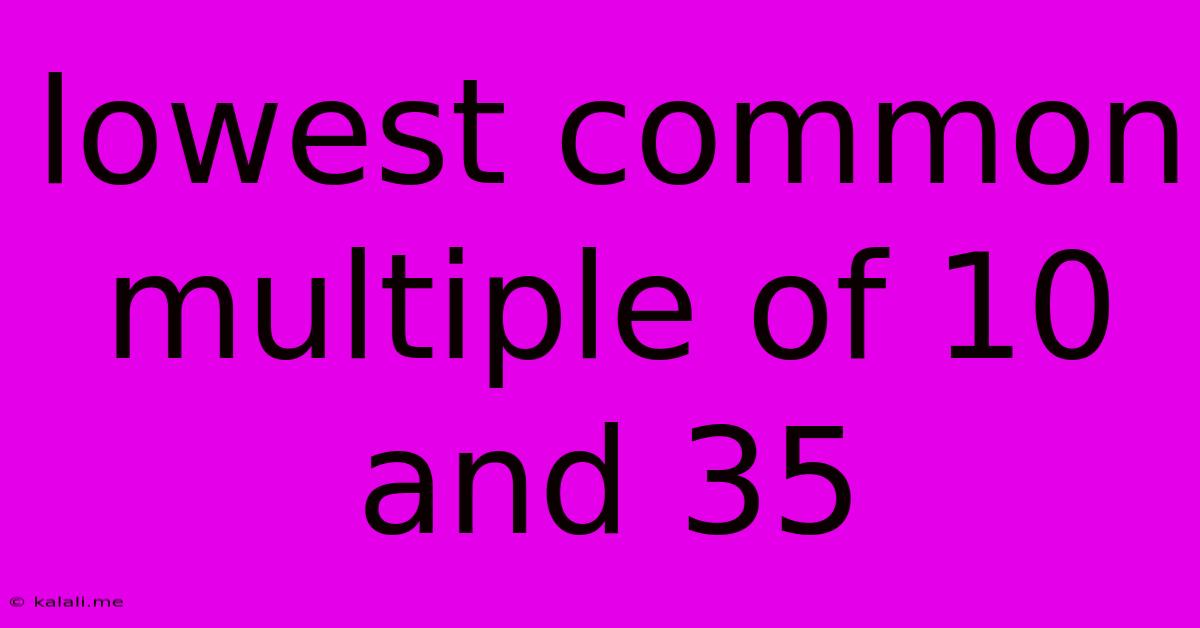Lowest Common Multiple Of 10 And 35
Kalali
Jun 14, 2025 · 2 min read

Table of Contents
Finding the Lowest Common Multiple (LCM) of 10 and 35
Finding the lowest common multiple (LCM) is a fundamental concept in mathematics, particularly useful in simplifying fractions and solving problems involving cyclical events. This article will guide you through calculating the LCM of 10 and 35, explaining the process step-by-step and demonstrating different methods you can use. Understanding LCM is crucial for various mathematical applications, from simplifying fractions to solving real-world problems involving timing and cycles. This article will help you master this essential skill.
What is the Lowest Common Multiple (LCM)?
The lowest common multiple (LCM) of two or more numbers is the smallest positive integer that is a multiple of all the numbers. In simpler terms, it's the smallest number that both (or all) numbers divide into evenly. For instance, finding the LCM is essential when determining the least amount of time until two events occur simultaneously. Imagine two machines that run on different cycles; the LCM tells you when they'll both be at their starting point again.
Methods for Finding the LCM of 10 and 35
There are several ways to determine the LCM of 10 and 35. We'll explore two common methods: the listing method and the prime factorization method.
1. Listing Multiples Method
This method involves listing the multiples of each number until you find the smallest multiple they have in common.
- Multiples of 10: 10, 20, 30, 40, 50, 60, 70, 80, 90, 100...
- Multiples of 35: 35, 70, 105, 140...
By comparing the lists, we can see that the smallest multiple common to both 10 and 35 is 70. Therefore, the LCM of 10 and 35 is 70.
This method works well for smaller numbers but can become cumbersome with larger numbers.
2. Prime Factorization Method
This method is more efficient, especially for larger numbers. It involves finding the prime factorization of each number and then building the LCM from the highest powers of each prime factor present.
- Prime factorization of 10: 2 x 5
- Prime factorization of 35: 5 x 7
To find the LCM, we take the highest power of each prime factor present in either factorization:
- Highest power of 2: 2¹ = 2
- Highest power of 5: 5¹ = 5
- Highest power of 7: 7¹ = 7
Multiply these together: 2 x 5 x 7 = 70
Therefore, the LCM of 10 and 35 using prime factorization is also 70. This method provides a more systematic and efficient approach, especially when dealing with larger numbers or finding the LCM of more than two numbers.
Conclusion:
Both methods accurately determine that the lowest common multiple of 10 and 35 is 70. The prime factorization method, however, is generally preferred for its efficiency and applicability to more complex scenarios. Understanding the LCM is a fundamental skill with far-reaching applications in various mathematical and real-world contexts. Now you are equipped with the knowledge and methods to tackle LCM problems confidently!
Latest Posts
Latest Posts
-
Which Of The Following Is A Current Transformer
Jun 14, 2025
-
Muscle Fatigue Is Caused By
Jun 14, 2025
-
Absolute Zero Corresponds To A Temperature Of
Jun 14, 2025
-
Which Country Is Lake Victoria In
Jun 14, 2025
-
Economics Can Be Best Defined As The Study Of
Jun 14, 2025
Related Post
Thank you for visiting our website which covers about Lowest Common Multiple Of 10 And 35 . We hope the information provided has been useful to you. Feel free to contact us if you have any questions or need further assistance. See you next time and don't miss to bookmark.